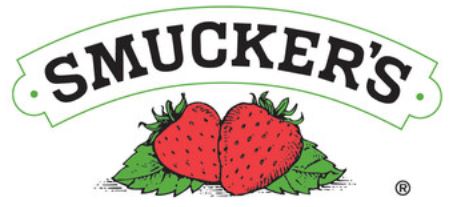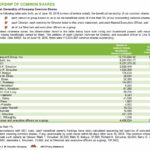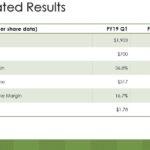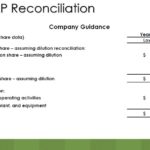Contents
While investors wait for this transformation to generate the desired results, there is a conservative way in which investors can augment their return on investment.
Summary
- SJM released Q1 results on August 21st that were not well received by Mr. Market.
- The company is in the process of transforming its business to focus on higher growth lines of business.
- I am employing a conservative option strategy which should enable me to generate income that far exceeds the dividend income generated from my SJM holding.
Introduction
Far too often I read articles about retirees stretching their dollars so they don’t run out of money. I knew that if I were ever in this financial predicament my health would suffer. I, therefore, set a goal early in my career to create a portfolio of investments which would generate income to support our needs. I also raised the bar fairly high as I vowed to get off the ‘work treadmill’ earlier than customary.
I had absolutely no idea whether my goals were achievable or not but I figured that if I followed the teachings of several highly successful investors I stood a far better chance of achieving them. I have followed the teachings of the likes of Buffett / Munger and have endeavored to invest in great companies without worrying about stock price fluctuations.
These teachings have certainly come in handy when I look at my investment experience with The J.M. Smucker Company (NYSE: SJM); I certainly did not invest in SJM at the most opportune time as my initial investments were made in June and July 2017 when SJM’s stock price was a shade higher than the current stock price!
In today’s article I touch upon SJM’s August 21 release of its Q1 results. Mr. Market has not reacted kindly to these results but I am not concerned. The company is undergoing a significant transformation and while this is happening I see an opportunity to generate annual income that is ~15% (~$7,390) of my initial ~$49,250 investment.
Business Overview
SJM’s principal products are coffee, pet food and pet snacks, peanut butter, fruit spreads, shortening and oils, baking mixes and ready-to-spread frostings, frozen sandwiches, flour and baking ingredients, juices and beverages, and portion control products. Most readers will be familiar with several of SJM’s brands.
Founded in 1897 and incorporated in Ohio in 1921, SJM continues to be predominantly a US centric company with ~94% of net sales being derived from the US market.
SJM has the following 4 reportable segments:
- U.S. Retail Coffee;
- U.S. Retail Consumer Foods;
- U.S. Retail Pet Foods;
- International and Away From Home.
A significant portion of SJM’s strategic focus is the sale of branded food and beverage products with leadership positions to consumers through retail outlets in North America; the U.S. retail market segments in total comprised ~85% of SJM’s 2018 consolidated net sales.
The International and Away From Home segment represents sales outside of the U.S. retail market segments.
The competitive environment has certainly been challenging for most companies within the North American Consumer Goods – Processed and Packaged Goods space and SJM has not been immune to these challenges.
It has managed to offset category erosion in some of its legacy businesses. It does, however, continue to be threatened by difficult market dynamics in the center of the grocery store. Brand values are eroding as competition increases and consumers are gravitating toward fresh items.
Having identified the pet food business as an opportunity to grow and diversify, SJM has completed two pet food related acquisitions.
2015 – Big Heart Pet Brands, a leading producer, distributor, and marketer of premium-quality, branded pet food and pet snacks in the U.S.
2018 - Ainsworth Pet Nutrition, LLC, a leading producer, distributor, and marketer of premium pet food and pet snacks, predominantly within the U.S.
The pet food acquisitions have certainly transformed SJM and once SJM divests itself of its US baking business, it will be deriving ~40% of its annual projected sales from the pet food side of the business. This is certainly quite the transformation considering SJM was not in this line of business prior to 2015!
The consumer landscape continues to evolve at an ever increasingly rapid pace. There is significant competition in middle aisles with the value of many brands having diminished in recent years.
Furthermore, consumer tastes are evolving. This means SJM must quickly adapt to these changing consumer tastes so as to offset whatever erosion may occur in its legacy brand.
The following are examples of how SJM has had to recently adapt.
It struggled with its K-Cup coffee sales but the introduction of Dunkin’ Donuts-branded pods has boosted the company’s market share in this sector.
The Jif peanut butter brand has been extended into snack bars, other nut butters, and powders. This has enabled SJM to capitalize on increasing consumer demand for protein.
As far as the pet food sector goes, SJM’s 2015 acquisition of Big Heart has certainly benefited SJM because of the overall attractiveness of the pet sector and the ability for SJM to emphasize the faster-growing premium subcategories.
The pet food industry is somewhat similar to the consumer food industry as pet owners are becoming increasingly focused on natural and health-oriented product. The pet food industry, however, does differ from the consumer food industry in that the product offerings differ significantly between conventional mass retail and specialty pet stores.
Interestingly, the pet food sector features greater brand loyalty as consumers are hesitant to switch away from a product that their pet tolerates. The reluctance on the part of pet owners to switch to private-label pet food means that ~12% of pet food is private label (~20% private-label penetration for U.S. food and beverage for human consumption).
Stewardship
The following table reflects the Beneficial Ownership of Company Common Shares.
Source: SJM – FY2018 Proxy Statement
I can appreciate how some investors might be hesitant to invest in companies with:
- a Dual class share structure in which one class of shares is owned predominantly by insiders and the voting rights attached to the voting class of shares greatly outweighs that of the ‘regular’ shares;
- one class of shares but the founding family essentially has voting control so the outcome of the vote on any investor proposal ends up being in favor of how the founding family votes.
Personally, I have no problems with these share structures…..in some cases.
Quite frankly, if I own a few thousand shares in a company, my vote is immaterial in the grand scheme. My primary concern is whether the Board and senior management are making decisions that are in the best interest of the company.
I recognize management must make short- and long-term decisions but when I know that a significant proportion of the “voting shareholders’” have their wealth tied up in the company, I am inclined to think that decisions are being made primarily on the basis of how those decisions will impact the company well into the future.
Sometimes difficult decisions must be made that will negatively impact the company in the short-term. Where a company has a Dual class share structure or where the founding family has voting control, there is probably less likelihood that decisions will be made on the basis of how management perceives the investment community will react when tough decisions must be made.
SJM is such an example of the above.
The Smucker family holds a modest ~4% equity ownership and two family members hold the positions of Executive Chairman and President and CEO.
In FY2018, executive remuneration was heavily weighted between annual and long-term incentives and stock options that vest over time; base salary constituted 14% of total CEO compensation and around 20% of key nonexecutive officers’ pay. I like this compensation structure in that Executives have significant incentive to ensure the decisions they make will be beneficial in the long-term.
Many in the investment community have seriously questioned the high price paid in the 2015 Big Heart acquisition (SJM participated in a competitive bidding process and ended up paying $5.8B or 13 times EBITDA). Despite knowing there would be a very high probability that the investment community would be critical of the price SJM paid for Big Heart, management felt a radical transformation of the company was required for SJM to thrive in the future.
Q1 Financial Results
On August 21 SJM released its Q1 results.
Source: SJM – Q1 2019 Earnings Presentation – August 21, 2018
These results include the anticipated net proceeds from the divestiture of its US baking business ($0.315B after transaction costs and taxes) which includes well known brands such as Pillsbury®, Martha White®, Hungry Jack®, White Lily®, and Jim Dandy®. Proceeds will be deployed toward the development of a stronger presence in pet food, coffee, and snacking which are large, growing categories with sustainable growth projections.
2019 Guidance
Guidance for FY2019 reflects:
- the anticipated impact of the US baking business divestiture based on an August 31 expected transaction close date;
- a reduction in net sales guidance due to lower than anticipated net sales in Q1.
The reduction in projected adjusted EPS reflects the following factors:
- estimated impact from US baking business divestiture;
- foregone profit related to the U.S. baking business for the last 8 months of fiscal 2019;
- an anticipated gain related to the transaction;
- a benefit from the use of net proceeds from the divestiture.
Free cash flow guidance has also been revised lower primarily due to the forgone profit related to the impending divestiture.
Source: SJM – Q1 2019 Earnings Presentation – August 21, 2018
Credit Ratings
In my opinion, far too many investors overlook the credit risk aspect of the company in which they are investing and should pay closer attention to the level of risk presented. This is why I look at a company’s credit ratings assigned by major ratings agencies.
SJM’s long-term unsecured credit rating was downgraded in 2015 as a result of the additional debt it took on for the purpose of acquiring Big Heart Pet Brands. In fact, Moody’s lowered the credit rating two notches from A3 (the lowest tier in the upper medium grade category) to Baa2 (middle tier of the lower medium grade category).
In 2015, S&P Global also downgraded SJM long-term unsecured debt to BBB (the middle tier of the lower medium grade category) which is one tier lower than Moody’s rating.
Subsequent to these downgrades, SJM’s credit ratings have remained stable.
The deterioration in SJM’s credit quality was certainly a factor I took into consideration when I initiated my SJM investment in 2017. I, however, felt that the credit ratings were acceptable from my perspective and that the assumption of this significant additional debt was required in order for SJM to make the essential strategic changes required for SJM to become a stronger company in the future.
If SJM’s credit ratings were to once again come under review with negative implications, however, I would seriously reconsider my continued investment in SJM.
Valuation
On the basis of projected FY2019 adjusted EPS in the range of $8.40 - $8.65 and SJM’s current stock price of ~$109.50 I get a forward adjust PE range of ~12.66 - ~13.
SJM is undergoing a significant transformation so I am reluctant to compare this forward PE range with SJM’s 5 year historical PE of ~24.
My view that SJM is attractively valued is based primarily on the basis that SJM’s current forward PE range is similar to that during the height of the Financial Crisis.
In my opinion, the investment community is being far too harsh with its valuation of SJM.
Dividend and Dividend Yield
SJM’s dividend history can be found here.
On July 13, SJM announced an increase in its quarterly dividend from $0.78 to $0.85 ($3.40/annually) with this new dividend payable September 4 to shareholders of record at the close of business on August 17.
Based on the current ~$109.50 stock price, investors could generate a 3.1% dividend yield if an investment were made at the current stock price.
Option Strategy
Some investors may view SJM’s dividend yield as being unacceptable given the challenges SJM is currently experiencing. I fall in this category, and therefore, am employing a conservative ‘covered call’ option strategy to generate additional income from my SJM shares; these shares are held in the FFJ Portfolio.
In November 2017 I wrote 4 July 2018 covered calls with a $125 strike price which generated USD ~$1,145 (after fees); these calls expired thus resulting in me retaining my shares.
I have recently written another 4 covered call contracts with a $125 strike price that expire September 2018. This has generated another USD $585 (after fees) in option income.
I do not envision SJM’s stock price rising to the $125 level by expiry but should SJM approach this strike price I will likely close out my position and write new contracts to expire in October.
My game plan is to continue to write short duration covered calls to generate additional income which can then be deployed to acquire shares in attractively valued companies.
Final Thoughts
I view my investment strategy with SJM as trying to make lemonade from what has been a lemon (at least to date).
SJM is undergoing a significant change to its business and the investment community does not, on the whole, appear to be reacting positively as evidenced by how SJM’s stock price has fared since mid-2016. Sometimes, however, management has to make tough decisions for the long-term benefit of the company that are not always popular with the investment community.
I think SJM is making the right changes to its business but I recognize the risk is somewhat elevated. In exchange for this higher level of risk I want to be adequately compensated. As a result, I am employing a conservative covered call option strategy and expect to generate at least USD $500/month in option income.
My objective with my SJM investment is to generate ~$6,000/year in option income and ~$1,390/year in dividend income in the current fiscal year on my initial ~$49,250 investment; this would be a ~15% annual return.
I strongly suspect many investors will be reluctant to initiate a position in SJM. If you happen to currently be a SJM investor, however, I hope the conservative option strategy presented in this article has provided you with an idea by which you can generate additional income from your investment while you patiently wait for SJM to complete its transformation.
I hope you enjoyed this post and I wish you much success on your journey to financial freedom.
Thanks for reading!
Note: I sincerely appreciate the time you took to read this article. Please send any feedback, corrections, or questions to [email protected]
Disclaimer: I have no knowledge of your individual circumstances and am not providing individualized advice or recommendations. I encourage you not to make any investment decision without conducting your own research and due diligence. You should also consult your financial advisor about your specific situation.
Disclosure: I am long SJM.
I wrote this article myself and it expresses my own opinions. I am not receiving compensation for it and have no business relationship with any company whose stock is mentioned in this article.






